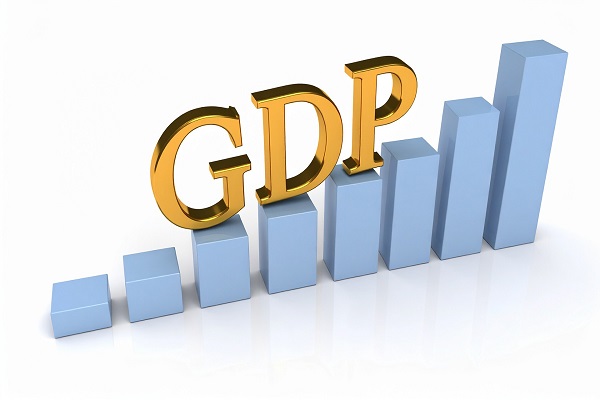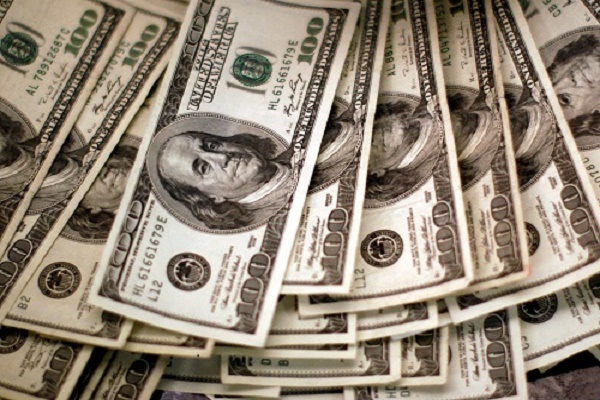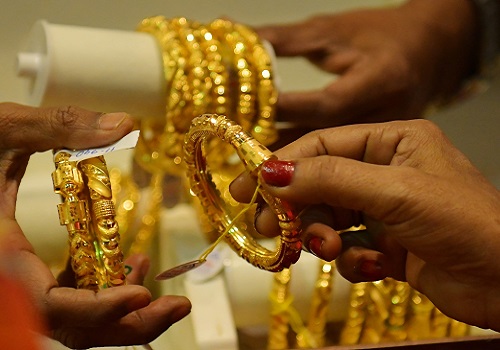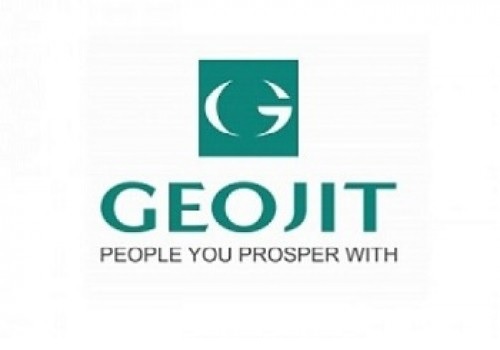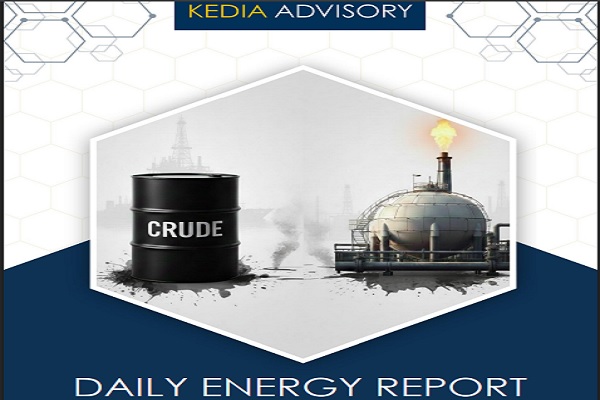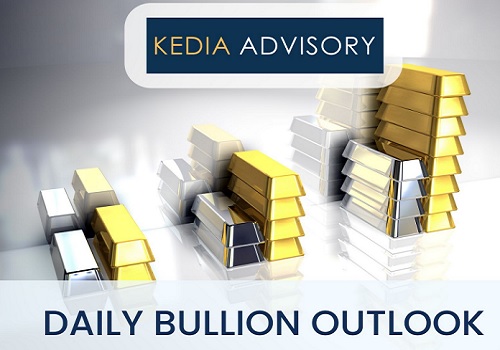Cottoncandy trading range for the day is 53550-54570 - Kedia Advisory

Gold
Gold prices settled 0.38% higher at Rs.85,809, supported by a weaker U.S. dollar and concerns over potential tariff policies from U.S. President Donald Trump, which could escalate global trade tensions. Investors closely monitored inflation data, as Federal Reserve Chair Jerome Powell reiterated that rate cuts were not imminent. The U.S. Producer Price Index (PPI) rose 0.4% in January, slightly above expectations, with food and energy leading the increase. Traders are now leaning towards a July rate cut, with odds falling from 60% to 52% after higher-than-expected wholesale inflation and lower jobless claims. On the physical demand front, India's gold consumption is expected to moderate in 2025 due to record-high prices, following last year’s peak demand of 802.8 metric tons. The World Gold Council forecasts demand between 700-800 metric tons, with jewellery demand under pressure but investment demand rising, particularly in gold ETFs, digital gold, and coins. Indian dealers continued to offer discounts of $31 per ounce to attract buyers. Meanwhile, China’s post-holiday demand remained subdued, with gold offered at a $7-$10 discount, while Japanese bullion traded between a $3 discount and a $1 premium. Technically, gold is witnessing fresh buying as open interest increased by 1.04% to 16,587, while prices rose Rs.328. Immediate support is seen at Rs.85,610, with a break below testing Rs.85,420. On the upside, resistance is at Rs.86,030, and a move above this level could push prices towards Rs.86,260.
Trading Ideas:
* Gold trading range for the day is 85420-86260.
* Gold rose supported by a weaker dollar and growing worries over U.S. President Trump's tariff plans.
* Ongoing trade war uncertainties kept the safe-haven metal's demand intact.
* Fed’s Jerome Powell reiterated that the central bank was in no rush to cut interest rates.
Silver
Silver prices settled 0.28% lower at Rs.95,233 as the dollar index rebounded after early losses, driven by investor concerns over U.S. President Donald Trump's trade policies. Trump hinted at new reciprocal tariffs, following the imposition of a 25% levy on aluminum and steel imports and a 10% tariff on Chinese goods. Meanwhile, expectations for Federal Reserve rate cuts weakened after higher-than-expected U.S. CPI and PPI data. Traders now anticipate only one quarter-point rate cut, likely in December, as wholesale prices rose faster than projected and jobless claims declined. The probability of a July rate cut dropped from 60% to 52% following the data. The Silver Institute forecasts a significant market deficit for the fifth consecutive year in 2025, driven by strong industrial demand and robust retail investment. Global silver demand is expected to remain stable at 1.20 billion ounces, with industrial fabrication projected to grow by 3% and surpass 700 million ounces for the first time. However, silver jewelry demand is expected to decline by 6%, with India accounting for most of the losses due to high local prices. Silver supply is set to rise by 3% to an 11-year high of 1.05 billion ounces, with mine production reaching a seven-year high of 844 million ounces. Technically, silver is under long liquidation, with open interest dropping by 1.49% to 19,862 while prices declined by Rs.269. Immediate support is at Rs.94,710, and a break below could test Rs.94,185. On the upside, resistance is at Rs.95,830, with a potential move towards Rs.96,425.
Trading Ideas:
* Silver trading range for the day is 94185-96425.
* Silver dropped as dollar index erased early losses as traders assessed President Trump's trade policies.
* Stronger-than-expected US CPI and PPI data tempered expectations for Federal Reserve rate cuts this year.
* Core producer prices in United States, rose by 0.3% over a month in January 2025.
Crude Oil
Crude oil prices settled 0.48% lower at Rs.6,196 as potential peace talks between Russia and Ukraine weighed on market sentiment. U.S. President Donald Trump indicated that both Russian President Vladimir Putin and Ukrainian President Volodymyr Zelenskiy expressed a willingness to negotiate peace, prompting U.S. officials to initiate discussions. Additionally, concerns over sustained Russian oil exports, despite new U.S. sanctions, further pressured prices. The International Energy Agency (IEA) reported a slight rise in Russian crude production last month, suggesting that workarounds to the sanctions could be found. The latest U.S. Energy Information Administration (EIA) data showed a higher-than-expected build in crude oil inventories, adding to the bearish outlook. U.S. crude stocks rose by 4.1 million barrels to 427.9 million barrels for the week ending February 7, surpassing the anticipated 3 million-barrel increase. Crude inventories at Cushing, Oklahoma, climbed by 872,000 barrels. Meanwhile, refinery crude runs increased by 82,000 barrels per day, while gasoline stocks fell by 3 million barrels. Distillate inventories rose slightly by 0.1 million barrels, contrary to the expected 1.5 million-barrel drop. Technically, crude oil remains under long liquidation, with open interest declining by 2.15% to 9,590 contracts while prices dropped Rs.30. Immediate support is at Rs.6,139, and a break below could test Rs.6,082. On the upside, resistance is at Rs.6,229, with a potential move towards Rs.6,262 if momentum strengthens.
Trading Ideas:
* Crudeoil trading range for the day is 6082-6262.
* Crude oil fell as a potential peace deal between Russia and Ukraine continued to exert downward pressure.
* U.S. crude stocks rose more than expected last week - EIA
* IEA lowered its global oil surplus projections, highlighting strong demand in Asia and sanctions on OPEC+ nations.
Natural Gas
Natural gas prices climbed 2.69% to Rs.316.5, driven by increased LNG export flows, a dip in daily production, and forecasts of colder weather boosting heating demand. Despite expectations of milder weather in late February, strong near-term demand supported prices. U.S. gas output in the Lower 48 states rose to 105.9 billion cubic feet per day (bcfd) in February, up from 102.7 bcfd in January when freeze-offs impacted production. This remains above the previous record of 104.6 bcfd set in December 2023. Meteorologists project colder-than-normal conditions until February 23, followed by near-normal temperatures from February 24-27. As a result, gas demand, including exports, is expected to increase from 135.5 bcfd this week to 142.0 bcfd next week. U.S. LNG exports have also surged, averaging 15.2 bcfd in February, up from 14.6 bcfd in January. Storage withdrawals exceeded expectations, with a 100 billion cubic feet (bcf) draw reducing inventories to 2,297 bcf. This was larger than the projected 92 bcf withdrawal, as extreme cold drove record heating demand. Storage levels are now 9.7% below last year and 2.8% below the five-year average. Technically, the market is experiencing short covering, with open interest falling by 2.36% to 15,899 contracts while prices gained Rs.8.3. Immediate support is at Rs.309.3, with a break below potentially testing Rs.302.2. Resistance is at Rs.325.2, and a move above could push prices toward Rs.334.
Trading Ideas:
* Naturalgas trading range for the day is 302.2-334.
* Natural gas gained on rising flows to LNG export plants, a drop in daily output and forecasts for cold weather.
* U.S. natural gas output and demand will both rise to record highs in 2025 – EIA
* EIA projected dry gas production will rise from 103.1 bcfd in 2024 to 104.6 bcfd in 2025 and 107.3 bcfd in 2026.
Copper
Copper prices rose 0.42% to Rs.867.85 as concerns lingered over potential U.S. tariffs under Donald Trump’s policies, which could further disrupt global supply chains. The premium of U.S. Comex copper futures over London Metal Exchange (LME) copper surged to a record $920 per metric ton, up from $558, reflecting supply constraints. Additionally, traders continued increasing their net long positions for the sixth straight week, signaling sustained bullish sentiment. Robust U.S. manufacturing data and expectations of economic stimulus in China, the world's largest copper consumer, also supported prices. China aims to increase its domestic copper ore resources by 5-10% by 2027, highlighting its long-term demand outlook. Chile’s state copper commission, Cochilco, maintained its 2025 and 2026 price forecast at $4.25 per pound, expecting copper prices to remain above $4.00 for the next decade. The agency predicts a global copper deficit of 118,000 metric tons in 2024, followed by a surplus of 210,000 tons in 2025. Chile’s copper production is expected to rise 4.6% to 5.76 million tons this year and another 3.6% to 5.97 million tons in 2026. The global refined copper market showed a 131,000 metric ton deficit in November, significantly widening from 30,000 tons in October, indicating tightening supply. Technically, the market is under fresh buying, with open interest rising by 4.79% to 6,108 contracts while prices gained Rs.3.6. Immediate support is at Rs.863.1, with a break below testing Rs.858.2. Resistance is seen at Rs.870.9, with a move above potentially reaching Rs.873.8.
Trading Ideas:
* Copper trading range for the day is 858.2-873.8.
* Copper gains as concerns lingered that US President Trump could still target copper with tariffs.
* The latest data revealed that traders raised their net long position in copper for the sixth consecutive week.
* Strong manufacturing activity in US and expectations of further economic stimulus in China, also supported.
Zinc
Zinc prices fell 0.67% to Rs.266.8 as markets weighed the impact of U.S. President Donald Trump's decision to impose 25% tariffs on steel and aluminum imports starting March 12. However, the downside was limited due to expectations of aggressive fiscal stimulus from China, which is likely to sustain base metal demand. Supply concerns continued to support prices, with global mined zinc production falling for the third consecutive year in 2024. Additionally, China’s refined zinc production declined by 7% due to lower processing rates, while the Red Dog Mine in Alaska, responsible for 10% of global output, is set to slow in 2025 due to ore depletion. Despite optimism for improved credit demand, official data showed a decline in activity among China’s largest manufacturers in January. LME zinc inventories remained at their lowest levels since February 2024, adding to supply constraints. The global zinc market deficit narrowed to 52,900 metric tons in November from 65,400 tons in October, while the overall deficit stood at 33,000 tons for the first 11 months of 2024, compared to a surplus of 312,000 tons in the same period of 2023. In January 2025, China’s refined zinc production rose 1% month-on-month but declined 8% year-on-year. February production is expected to fall by over 8% due to holiday shutdowns and maintenance. Technically, the market is under long liquidation, with open interest declining by 4.53% to 2,615 contracts while prices dropped Rs.1.8. Zinc has support at Rs.265.5, with a break below testing Rs.264, while resistance is at Rs.269, and a move above could push prices to Rs.271.
Trading Ideas:
* Zinc trading range for the day is 264-271.
* Zinc dropped as markets continued to assess the impact of U.S. President Donald Trump's.
* However upside seen limited amid expectations of aggressive fiscal stimulus by the Chinese government.
* New aggregates showed that global mined zinc production fell for the third consecutive year in 2024.
Aluminium
Aluminium prices fell by 0.43% to Rs.256.55 as traders assessed the potential risks of a global trade war following the implementation of a 25% tariff on steel and aluminium imports by U.S. President Donald Trump. Market pressure also came from rising aluminium stocks at three major Japanese ports, reaching 324,700 metric tons by the end of January, up 0.3% from the previous month. Morgan Stanley warned that aluminium would bear the brunt of these tariffs, given its widespread use in transportation, construction, and packaging. In China, production reached a record 44 million tons in 2024, approaching the government-imposed cap of 45 million tons. The U.S. aluminium premium over the London Metal Exchange benchmark surged by 60% since Trump’s re-election in November 2024.China’s aluminium production in January 2025 increased by 3.8% year-on-year but declined by 0.3% month-on-month. Domestic operating capacity remained stable, with only Shanxi smelters reporting a 20,000 mt/year production cut. Meanwhile, global primary aluminium output in December 2024 rose 3% year-on-year to 6.236 million tonnes. China’s unwrought aluminium exports grew 17% in the first ten months of 2024, totaling 5.5 million tonnes. Technically, the market is under long liquidation, with open interest dropping by 14.11% to 2,605 contracts while prices declined by Rs.1.1. Aluminium has support at Rs.255.4, with a break below testing Rs.254.2, while resistance is at Rs.258.4, and a move above could push prices towards Rs.260.2.
Trading Ideas:
* Aluminium trading range for the day is 254.2-260.2.
* Aluminium dropped as traders gauged the potential risks of a global trade war.
* China's central bank said it would adjust its monetary policy at the appropriate time to support the economy.
* Aluminium stocks at three major Japanese ports rose to 324,700 metric tons by the end of January, up about 0.3%.
Cottoncandy
Cottoncandy futures declined by 0.11% to Rs.54,040 as the Cotton Association of India (CAI) revised its crop projections upward by 2 lakh bales for the 2024-25 season, estimating total production at 304.25 lakh bales of 170 kg each. The revision is primarily due to increased output in Telangana, where production estimates were raised by 6 lakh bales. Additionally, domestic consumption is also expected to rise by 2 lakh bales, reflecting emerging market trends. The Cotton Corporation of India (CCI) is projected to purchase over 100 lakh bales at the Minimum Support Price (MSP) in the current cotton year, further influencing market sentiments. On the global front, Brazil’s 2024-25 cotton production forecast was reduced to 3.79 million tonnes from 3.83 million tonnes due to lower planted acreage in Mato Grosso. In the U.S., the 2024/25 cotton balance sheet saw minimal changes, with mill use reduced by 100,000 bales and ending stocks raised accordingly, leading to a stocks-to-use ratio of 39%. The season average upland farm price projection was lowered to 63.5 cents per pound. Meanwhile, world cotton production and ending stocks were increased due to a 1-million-bale rise in China's cotton crop, although declines in Argentina and Kazakhstan offset some of these gains. Technically, the market is under long liquidation, with open interest remaining unchanged at 258 contracts while prices dropped by Rs.60. Cottoncandy has support at Rs.53,790, and a break below could lead to Rs.53,550, while resistance is seen at Rs.54,300, with a potential test of Rs.54,570 if momentum strengthens.
Trading Ideas:
* Cottoncandy trading range for the day is 53550-54570.
* Cotton dropped as CAI has revised upwards its crop projections by 2 lakh bales of 170 kg each.
* CCI is likely to buy more than 100 lakh bales of cotton at MSP during the current cotton year.
* Brazil's 2024-25 cotton production forecast was revised down to 3.79 million tonnes from 3.83 million tonnes in December
* In Rajkot, a major spot market, the price ended at 25524.65 Rupees dropped by -0.12 percent.
Turmeric
Turmeric prices fell by 1.98% to settle at 12,992 due to weak demand and increased arrivals in key markets. The ongoing harvesting season has resulted in a surge in supply, with arrivals jumping to 13,190 bags from 6,780 bags in the previous session, particularly in Nizamabad and Hingoli. As harvesting progresses and more crops arrive in the coming weeks, prices are expected to remain under pressure. However, the downside is limited as new crop yields are estimated to be 10-15% lower this year, especially in the Nanded region, where smaller rhizomes and crop rots have affected production. Farmers have reported concerns over lower yields, making it crucial to monitor the progress of harvesting in major producing regions. On the trade front, turmeric exports from April to November 2024 increased by 9.80% to 121,601.21 tonnes compared to the same period in 2023. However, November 2024 exports fell by 20.18% from October but remained 48.22% higher than November 2023. Meanwhile, turmeric imports surged by 101.80% during April-November 2024 to 18,937.95 tonnes compared to the previous year. November imports declined by 34.84% from October and were slightly lower than November 2023 levels. Technically, turmeric is under long liquidation as open interest dropped by 2.21% to 11,940 while prices declined by 262. The immediate support level is at 12,856, with a break below potentially testing 12,722. Resistance is seen at 13,196, and a move above this could push prices toward 13,402.
Trading Ideas:
* Turmeric trading range for the day is 12722-13402.
* Turmeric prices dropped on weak demand and marginal improvement in arrivals.
* New crop yields are expected to be 10-15% lower this year.
* Farmers have indicated that the yield may be lower than expected.
* In Nizamabad, a major spot market, the price ended at 13150.35 Rupees gained by 0.23 percent.
Jeera
Jeera prices gained 0.75% to settle at 20,780, supported by low-level buying after recent declines. Despite weak domestic demand, Indian cumin remains the cheapest in the global market, attracting international buyers. However, demand is currently being met from available stock, with farmers still holding around 20 lakh bags. By the end of the season, only 3-4 lakh bags are expected to be traded, leaving a carry-forward stock of approximately 16 lakh bags. The current season’s production is projected to remain stable compared to last year, with improved crop conditions and good sowing activities. According to the Spices Board, India’s cumin seed production rose to 8.6 lakh tonnes in 2023-24, up from 5.77 lakh tonnes in the previous year, benefiting from increased sowing across 11.87 lakh hectares. Export trends remain positive, with cumin exports surging by 74.04% to 147,006.20 tonnes during April-November 2024 compared to the same period in 2023. However, November exports declined by 28.92% from October but were still 42.67% higher year-on-year. The recent geopolitical tensions in the Middle East have contributed to increased demand from international buyers, especially from Europe and China. Technically, the market is witnessing short covering as open interest remained unchanged at 2,721 while prices increased by 155. Immediate support is at 20,620, and a break below could lead to testing 20,440 levels. Resistance is seen at 20,910, and a move above this level could push prices towards 21,020.
Trading Ideas:
* Jeera trading range for the day is 20440-21020.
* Jeera gained on low level buying after prices dropped as demand is low.
* However, only 3-4 lakh bags are expected to be traded by the end of the season, leaving a carry-forward stock of about 16 lakh bags.
* The current season is expected to have similar production levels as last year due to better crop conditions and good sowing.
* In Unjha, a major spot market, the price ended at 20940.1 Rupees dropped by -0.37 percent.
Views express by all participants are for information & academic purpose only. Kindly read disclaimer before referring below views

